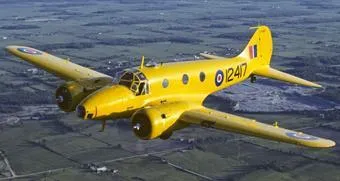Avro Anson

Canadian Warplane Heritage Museum
The Museum's Anson Mk. V was built by MacDonald Brothers in Winnipeg in 1944. It flew with No. 7 Photographic Wing and No. 414 Squadron in Ottawa on photo survey work until the late 1940s. In 1956, it was purchased by INCO and used for mineral surveying until 1980, when it was donated to the Museum. The exterior is painted in the yellow colour common to all BCATP trainers and is in its same wartime RCAF markings.
The Avro Anson was known by a number of nicknames including "Faithful Annie" or "Flying Greenhouse". It was the first aircraft to be flown by the Royal Canadian Air Force to have a retractable undercarriage, which was a comparative novelty in 1936. In 1940, a Canadian government owned company, Federal Aircraft Limited, was created in Montreal to manufacture the Anson for Canadian use. Nearly 3,000 Anson aircraft were produced and, in the early days of the British Commonwealth Air Training Plan (BCATP), the Anson was the standard trainer for many pilots, observers (navigators), wireless operators and bomb aimers. More than 20,000 aircrew received training on the Anson. In Canadian service, the aircraft was substantially re-designed with the substitution of North American engines and many other airframe and equipment changes. Harold Skaarup web pages
CASPIR Aircraft Groups:
RCAF On Strength (4404), RCAF 400 Squadron (6), Canadian Aircraft Losses (257)Anson Mk. V 11886
First assigned to No. 8 Air Observer School at Ancienne Lorette, Quebec. Still with this School when it crashed at 03:00 on 16 July 1944. Ran out of fuel during a night time navigation exercise, and forced landed in the St. Lawrence River 2 miles off shore near St. Anne de la Pocatiere, Quebec. Two RAF students, LACs C.T. Davey and A.M.A. Goddard killed, pilot and wireless operator survived, rescued by local ferry boat. Pilot reported bad weather led to becoming lost. Body of LAC Davey found on 31 July 1944, body of LAC Goddard found on 9 August 1944. Ownership to No. 9 Repair Depot on 22 July 1944, for scrapping.
1944-01-15 Taken on Strength No. 3 Training Command 2019-08-20
1944-July-16 Accident: 8 Air Observer School Loc: 47° 25° N 70° 12° W Names: Brennan | Brown | Davey | Goddard
1944-09-13 Struck off Strength Struck off, reduced to spares and produce 2019-08-20





 Commonwealth War Graves Commission
Commonwealth War Graves Commission Library and Archives Canada Service Files (may not exist)
Library and Archives Canada Service Files (may not exist) Harold A Skaarup Web Page
Harold A Skaarup Web Page Avro Anson History
Avro Anson History RCAF.info - RCAF Station L'Ancienne Lorrette QC
RCAF.info - RCAF Station L'Ancienne Lorrette QC